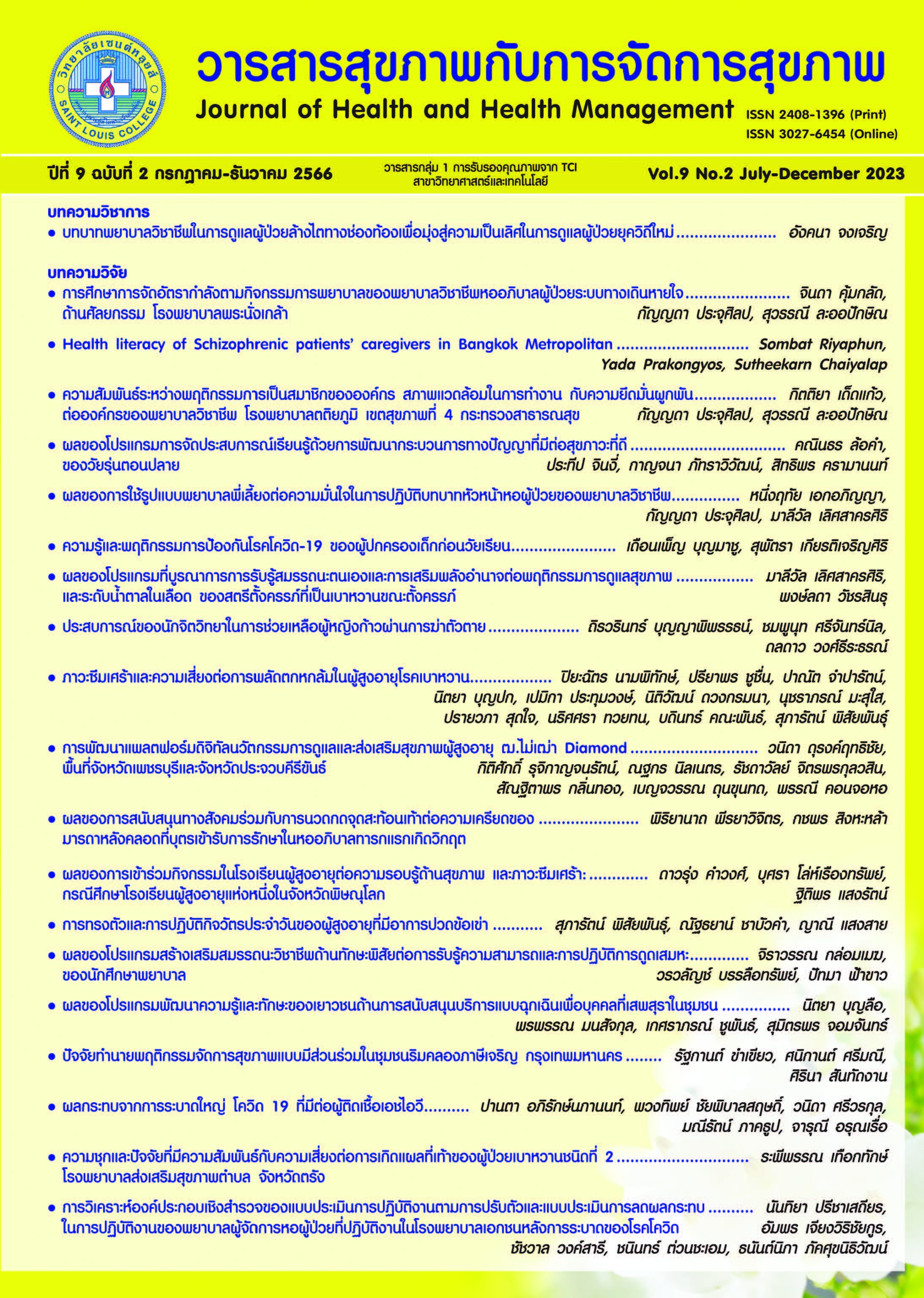Role of Registered Nurse in Peritoneal Dialysis Patients Caring towards Best Nursing Practice in New-Normal Era
Keywords:
best nursing practice, Peritoneal dialysis patient, New-Normal EraAbstract
This article aims to present the specific roles of peritoneal dialysis(PD) nurses after the COVID-19 outbreak. This outbreak leads to changes in lifestyles which are different from the past. The role of PD nurses, in addition to having knowledge in nursing practice for specific groups of patients, also need to know the appropriate innovation and technology which is suitable for the end stage kidney disease (ESKD) patient in the new normal era. To design patient care program for the patient to perform home-based peritoneal dialysis by oneself, to prevent and control infection and spread of germs. The key components of the best nursing practice in caring for ESKD patients consist of 9 aspects: 1) Counseling for pre-dialysis 2) Caring for patients who decided to PD 3) Teaching in how to perform PD in the new-normal era 4) Peritonitis assessment and prevention 5) Evaluating the adequacy of PD 6) Follow-up and home visit 7) Providing knowledge about managing oneself and one’s family 8) Psychological promotion and support, and 9) Further development in innovation production. All components should be adjusted and adapted for each patient’s specific situation and keep track of reviewing the new knowledge to care for patients with PD regularly. To create the best outcome and quality of care for patients with PD and to promote the best quality of care for patients and family in the new normal era.
References
กองการพยาบาล สำนักงานปลัดกระทรวง กระทรวงสาธารณสุข. (2561). บทบาทหน้าที่ของพยาบาลวิชาชีพ. กรุงเทพฯ: บริษัทสำนักพิมพ์สื่อตะวัน จำกัด.
กิตติยา เตชะไพโรจน์, สมไสว อินทะชุบ, เนาวนิตย์ พลพินิจ และมณฑิรา ฮังกาสี. (2562). การพัฒนาระบบการพยาบาลผุ้ป่วยล้างไตทางช่องท้องที่มีการติดเชื้อ โรงพยาบาลอุดรธานี. วารสารวิชาการแพทย์เขต 11, 33(3), 565-580.
จินตนา อาจสันเที๊ยะ, แสงวรรณ ตั้งแสงสกุล, และสายสมร เฉลยกิตติ. (2565). การเยี่ยมบ้านวิถีใหม่: บทบาทพยาบาลชุมชนไทยต่อการป้องกันและควบคุมการระบาดของโรคติดเชื้อ โคโรนาไวรัส (โควิด 19). วารสารสุขภาพกับการจัดการสุขภาพ, 8(1), 1-13.
ดาราวรรณ รองเมือง, อินทิรา สุขรุ่งเรือง, สราพร มัทยาท, ภัทรพงศ์ อุดมพัฒน์, อติญาณ์ ศรเกษตริน, สุทธานันท์ กัลกะ, ..., และอนันต์ กนกศิลป์;. (2564). การพัฒนาระบบแพทย์ทางไกลเพื่อการดูแลรักษาผู้ป่วยล้างไตทางช่องท้อง บทเรียนจากการระบาดของโควิด-19. สืบค้นจาก https://kb.hsri.or.th/dspace/handle/11228/5846?locale-attribute=th
ทัศนา นิลพัฒน์, ศิริพร สวณะสกล, พนิดา เลิศปิยะธนากุล, และสดากาญจน์ เอี่ยมจันทร์ประทีป. (2563). การพัฒนารูปแบบการดูแลผู้ป่วยล้างไตทางช่องท้องแบบต่อเนื่องโดยใช้ระบบพยาบาลเจจ้าของไข้ในโรงพยาบาลสุราษฎร์ธานี. วารสารวิชาการแพทย์เขต11, 34(4), 223-239.
เบญจมาศ ปรีชาคุณ, ฤชุตา โมเหล็ก, ดารารัตน์ ชูวงศ์อินทร์, เพ็ญพักตร์ กองเมือง และมาริษา สมบัติบูรณ์. (2563). การพยาบาลในยุคเทคโนโลยีแห่งข้อมูล Nursing in Data Technology Era. The Journal of Chulabhorn Royal Academy, 3(1), 19-39.
ศรินยา พลสิงห์ชาญ และคมวัฒน์ รุ่งเรือง. (2565). ปัจจัยที่ส่งผลต่อพลังสุขภาพจิตของผู้ป่วยไตวานเรื้อรังระยะสุดท้ายที่ได้รับการล้างไตทางช่องท้องอย่างต่อเนื่อง. วารสารพยาบาลกระทรวงสาธารณสุข, 32(2), 78-91.
ศิริอร สินธุ. (2565). การบำบัดทดแทนไต. สภาการพยาบาล. นนทบุรี: วูฮิงการพิมพ์.
สกุณา ช่างบู่ และศนิ บุญญกูล. (2565). เว็บแอพพลิเคชั่นสำหรับตรวจประเมินระยะของโรคในผู้ป่วยโรคไตเรื้อรังโดยใช้เทคโนโลยีปัญญาประดิษฐ์. ใน การประชุมนำเสนอผลงานวิจัยระดับบัณฑิตศึกษา ครั้งที่ 17 ปีการศึกษา 2565. กรุงเทพฯ : มหาวิทยาลัยหอการค้าไทย.
สมพร ชินโนรส และชุติมา ดีปัญญา. (2563). คุณภาพชีวิตและปัจจัยที่มีผลในผู้ป่วยที่ได้รับการล้างไต: การศึกษาเปรียบเทียบ. วารสารสุขภาพกับการจัดการสุขภาพ, 6(2), 40-54.
สมาคมโรคไตแห่งประเทศไทย. (2563). ข้อมูลการบำบัดทดแทนไต (Thailand Renal Replacement Therapy: Year2020). กรุงเทพฯ :สมาคมโรคไตแห่งประเทศไทย.
สำนักงานส่งเสริมเศรษฐกิจดิจิทัล. (2563). นวัตกรรม AI สู้ภัย COVID-19. สืบค้นจาก https://www.depa.or.th/th/article-view/ai-against-covid
อารี ชีวเกษมสุข. (2564). เทคโนโลยีดิจิทัลในการดูแลผู้ป่วย: สิ่งจำเป็นสำหรับพยาบาลโรคหัวใจและทรวงอกในศตวรรษที่ 21. วารสารพยาบาลโรคหัวใจและทรวงอก, 32(1), 1-13.
Bergjan, M., & Schaepe, C. (2016). Educational strategies and challenges in peritoneal dialysis: A qualitative study of renal nurses’ experiences. Journal of clinical nursing, 25(11-12), 1729-1739.
Bieber, S. D., Burkart, J., Golper, T. A., Teitelbaum, I., & Mehrotra, R. (2014). Comparative outcomes between continuous ambulatory and automated peritoneal dialysis: a narrative review. American Journal of Kidney Diseases, 63(6), 1027-1037.
Chamroensakchai, T., Leedumrongwattanakul, K., Takkavatakarn, K., Manuprasert, W., & Kanjanabuch, T. (2019). Peritoneal dialysis (PD) catheter-related peritonitis from Aureobasidium pullulans caused by poor caregiver’s hand hygiene. Medical mycology case reports, 25, 35-38.
Chen, C. H., & Teitelbaum, I. (2022). Peritoneal dialysis adequacy: a paradigm shift. Kidney Research and Clinical Practice, 41(2), 150.
Fox, D. E., Quinn, R. R., James, M. T., Venturato, L., & King-Shier, K. M. (2020). Social support in the peritoneal dialysis experience: a qualitative descriptive study. Retrieved from https://www.journals.sagepub.com/doi/epub/10.1177/2054358120946572
Krishna, V. N., Managadi, K., Smith, M., & Wallace, E. (2017). Telehealth in the delivery of home dialysis care: catching up with technology. Advances in chronic kidney disease, 24(1), 12-16.
Lew, S. Q. (2018). Telehealth in Peritoneal Dialysis: Review of Patient Management. In Advances in Peritoneal dialysis. Conference on Peritoneal Dialysis, 34(2018), 32-37.
National Kidney Foundation. (2023). Peritoneal dialysis. Retrieved from https://www.kidney.org/treatment-support.
Ronco, C., Manani, S. M., Giuliani, A., Tantillo, I., Reis, T., & Brown, E. A. (2020). Remote patient management of peritoneal dialysis during COVID-19 pandemic. Peritoneal Dialysis International, 40(4), 363-367.
Yang, Z., & Dong, J. (2020). Operational considerations for peritoneal dialysis management during the COVID-19 pandemic. Clinical kidney journal, 13(3), 322-327.
Downloads
Published
How to Cite
Issue
Section
License
Copyright (c) 2023 Journal of health and health management

This work is licensed under a Creative Commons Attribution-NonCommercial-NoDerivatives 4.0 International License.




